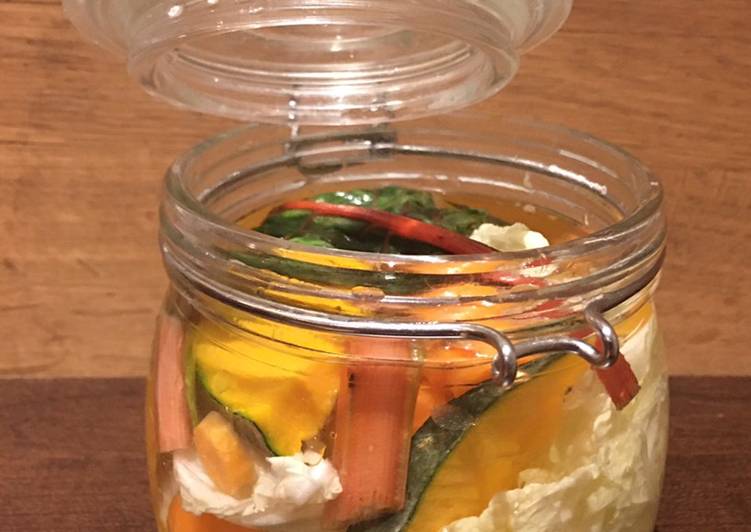
Hello everybody, hope you are having an incredible day today. Today, I’m gonna show you how to prepare a distinctive dish, fermented seasonal vegetables 🌱. One of my favorites. This time, I’m gonna make it a bit unique. This is gonna smell and look delicious.
Great recipe for Fermented seasonal Vegetables 🌱. Inspired by Cookpad's fermented project and a lot of amazingly delicious fermented foods I have eaten recently, this is a creation made from this weeks veg box. It has rainbow chard, cabbage, carrot, garlic and mustard seeds. Fermented vegetables begin with lacto-fermentation, a method of food preservation that also enhances the nutrient content of the food.
Fermented seasonal Vegetables 🌱 is one of the most popular of current trending foods in the world. It’s appreciated by millions every day. It’s easy, it’s quick, it tastes delicious. Fermented seasonal Vegetables 🌱 is something which I have loved my entire life. They are nice and they look wonderful.
To begin with this recipe, we must first prepare a few components. You can have fermented seasonal vegetables 🌱 using 6 ingredients and 5 steps. Here is how you cook that.
The ingredients needed to make Fermented seasonal Vegetables 🌱:
- Get clean jar
- Take Filtered water (I use a charcoal stick to filter)
- Make ready A selection of seasonal veg
- Prepare Seasalt flakes (see below)
- Make ready A selection of hard herbs and/or spices - I used mustard seeds in this one
- Get Ginger and/or garlic and/or chilli
The color of red cabbage can turn bluish during fermentation. Mixing green and red cabbage produces pink kraut (as in the picture). Store your fermented vegetables in a cool place once they have reached a flavor that you like. The refrigerator or a root cellar are great options.
Steps to make Fermented seasonal Vegetables 🌱:
- Clean the jar well. I used soapy water and popped it in the oven like you would when making pickles.
- Wash the veggies and chop to desired size.
- Using an electronic scale, place on your jar and return to zero. Fill the jar with your veg and spices. Using a jug of water, cover the veg to the top until they are fully submerged. Record weight total.
- Tip the water back into the jug. Do the maths to work our 2.5% of the recorded weight total. Add this quantity of salt to the water and stir until dissolved. Tip (now salty) water back until the jar until the veggies are submerged.
- You need to weight the veggies down so that they stay under the water. You can do this with a fermenting stone, a water bag or as I used a saucer with water poured on top. Secure the lid lightly without using the seal as it may explode. You can seal when it goes in the fridge. Leave to ferment for up to 7 days. Expect to see bubbles and life as you would sourdough. Store on a plate (see my sourdough 🤣)
Store your fermented vegetables in a cool place once they have reached a flavor that you like. The refrigerator or a root cellar are great options. The best vegetables to ferment are those that are in season and ripe, at the height of their optimal texture and flavor. Choose vegetables that were grown nearby, and opt for organic when possible. You can ferment one vegetable at a time, or pack several types together for a delicious "salad" of fermented vegetables.
So that is going to wrap it up with this special food fermented seasonal vegetables 🌱 recipe. Thank you very much for reading. I am confident you can make this at home. There’s gonna be interesting food at home recipes coming up. Remember to bookmark this page in your browser, and share it to your family, friends and colleague. Thanks again for reading. Go on get cooking!

